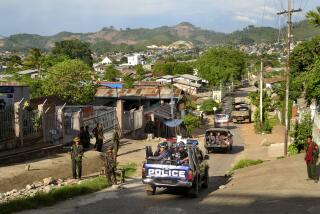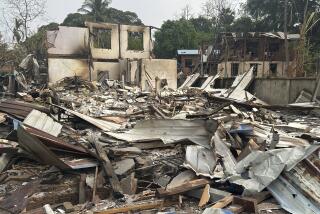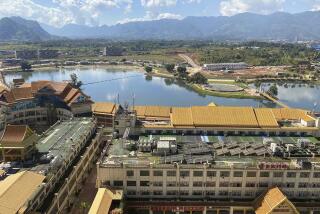Opium Growing Thrives in Rebel-Controlled Areas of Burma, Police Report Says
- Share via
CHIANG MAI, Thailand — In the still, cool mountains of Burma’s northern Shan state, flashes of white in remote valleys reveal the presence of enough opium poppy to keep an army of heroin addicts high for life.
The flowers are blooming in the rebel-controlled region, defended by a fearsome array of weaponry that its protectors say includes anti-aircraft missiles.
Burma’s secretive authorities gave a rare account of their uphill struggle to eliminate the poppies in a study prepared by the director of the Burma People’s Police, Hla Kyi, for a meeting here this autumn.
An impoverished and war-racked land and the world’s biggest source of opium, Burma normally keeps a tight grip on the flow of sensitive information.
Hla Kyi was coy about the full extent of rebel control in the northern states, saying, “Some of these areas are not under regular government administration.” But he conceded, “Without the insurgents, there would be no opium problem.”
The growing areas, usually between 3,000 to 6,000 feet in altitude, are mostly in ravines or on mountainsides inaccessible by road and where the army has been fighting ethnic and political rebel groups for 40 years.
“Most of the insurgent groups are not more than armed bands commanded by warlords, while others have an ideological aim at ethnic autonomy,” the report said. They depend on opium profits to fund their insurgencies.
The report was presented to a U.N.-organized seminar on poppy eradication at this northern Thai town in mid-December only a few hours drive from the Golden Triangle growing area.
Participants said the report was illustrated by slides of poppy fields nestling below towering mountains, U.S.-supplied Thrush aircraft spraying herbicide and rows of coffee bushes planted where once poppies bloomed.
Despite the government’s efforts, Hla Kyi estimated that 130 tons of opium would be produced in the hills of Shan, Kachin, Kayah and Shin states this winter season, mostly by small village peasants under the protection of rebels.
The report said 40,000 of 70,000 acres of opium poppy fields would be destroyed through aerial spraying and ground action this year, a figure considered optimistic by some other participants.
The United Nations puts Burma’s production at 500 to 600 tons, and U.S. officials say it is more than 1,000 tons.
Hla Kyi’s report said opium had been produced in Burma for about 100 years, both as a cash crop and as a cure for malaria, stomach complaints and other illnesses.
Herbicide spraying, also used against opium fields in Pakistan, started in 1985 from U.S.-donated aircraft. It is a laborious military operation, with troops having to secure the ground against guerrilla attack.
The most notorious of the opium warlords, Khun Sa, who commands some 2,000 men in Shan state close to the Thai border, has told visiting reporters he possesses ground-to-air missiles, a claim backed up by Thai security sources.
There have been no reports of attacks on any of the five Thrush aircraft, which swoop down to a height of about 100 feet to spray the herbicide on the drugs.
The report said the work had become increasingly difficult, with plantations moving to so-called brown and black areas--those more under rebel control-- which hampered “movement, communication and security.”
It said chains of trekkers or mule trains transport the raw opium to heroin factories near the Thai frontier. Attacks on the transports and factories netted more than five tons of raw opium and 430 pounds of heroin in 1987.
More to Read
Sign up for Essential California
The most important California stories and recommendations in your inbox every morning.
You may occasionally receive promotional content from the Los Angeles Times.










